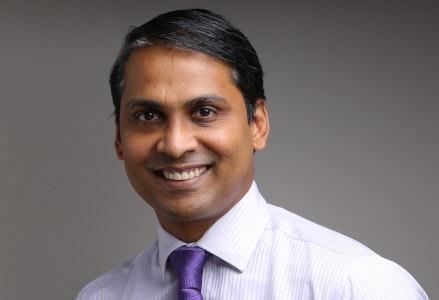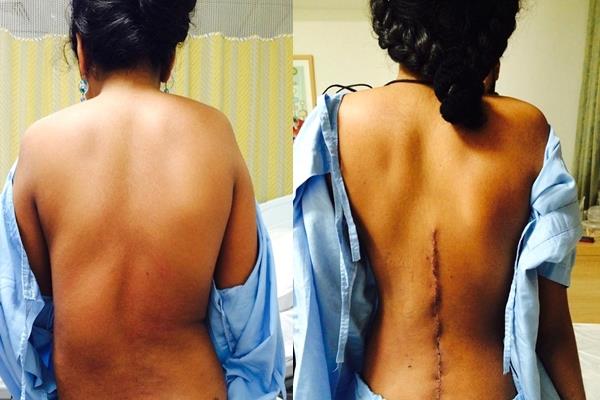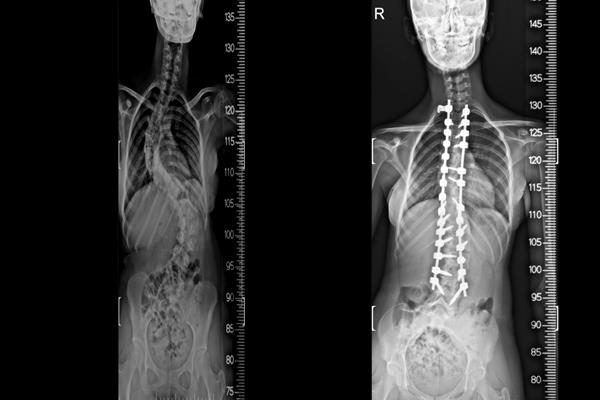|
|

|
|

| Article / Health / Bone Diseases | Post Comments |
Scoliosis In Children: How Corrective Surgery Can Transform Lives |
|
| By : Aster Medcity , Kochi , India 30.6.2018 1 Comments Phone:0484 669 9999 Mail Now | |
| Kuttisahib Road, Near Kothad Bridge, South Chittoor, Cheranalloor, Kochi, Kerala 682027 | |
 Dr Jacob Eapen MathewConsultant Spine SurgeonAster MedcityKochi Twelve year old Riya* was a loner. She didn’t like making new friends, she hated the idea of going for family functions, she disliked things that children of her age loved. The reason was her body. She had developed an abnormally bent, deformed spine – a condition called Scoliosis. This made her back look disfigured and gait (style of walking) - abnormal. She feared that people would make fun of her. When Riya’s parents brought her for a check-up, their apprehensions were many. People had made them believe that surgical correction of the condition may not be safe, as operating on the spine could lead to complications including paralysis. So the first thing that had to be set right was their unfounded fear. They were counselled about the severity of Riya’s condition and how a corrective surgery would transform not just her body, but her life itself.
After much deliberation, they finally decided to opt for the surgery as Riya’s
condition was going from bad to worse. Two days into the surgery, Riya looked at
herself in the mirror. The awe, the joy on her face said it all. Her parents
were in tears. A week later, Riya left the hospital, with a big smile on her
face. She was finally ready live a normal life. Scoliosis is a condition wherein a person’s spine or back is curved like an “S” or “C”. Worldwide estimates say that 3 out of every 100 people have some form of scoliosis, which either be congenital (deformity by birth), acquired or age-related. The severity of scoliosis differs from person to person. For those with minor scoliosis, the curve may not pose any problem at all. However, if the curve is severe or visible, it can lead to several complications including disfigurement, pain, breathing difficulties, heart problems and damage in the joints of the spine.
Early detection and correction is the key to effective management of scoliosis.
Early correction (surgical / non-surgical) can make a huge difference to the
treatment outcome in childhood scoliosis, as it is easier to rectify the
deformity in younger children. Scoliosis can occur in both children and adults. The most common type of scoliosis in children is Adolescent Idiopathic Scoliosis – “idiopathic” because the exact cause is not known. Adolescent scoliosis is seen more in girls than in boys.
The known causes of scoliosis include: In most cases, the scoliosis curve will be visible – which means that the spine, when viewed from the back, will curve into a “C” or “S” shape. In children, early stages of scoliosis may not be painful at all. The child may not be able to see or feel the problem. The abnormality in body shape and gait is usually detected by family members or teachers, who closely interact with the child. However, as the scoliosis progresses with time, there will be visible changes in the body symmetry and shape. Many teenagers with scoliosis have one shoulder blade that's higher than the other or an uneven waist that creates a tendency to lean to one side.
Diagnosis based on age: Scoliosis is a condition that’s treated by spine surgeons. The spine surgeon will examine of the spine to evaluate / measure the severity of the scoliosis curve in degrees (Cobb Angle). An MRI (Magnetic Resonance Imaging) of the spine may be done if the condition is not thought to be idiopathic If the scoliosis curve is about 10 or 15 degrees, there’s no treatment that’s required, except for regular check-ups till puberty. Usually, the spinal curvature does not worsen once the growth spurt is over. If the curve is between 20 to 40 degrees, a back brace may be recommended.
If the cobb angle is 40 to 50 degrees or more, surgical correction is the only
option as the curve(s) will continue to worsen with time. Non-Surgical Management In some cases, children with scoliosis may require to wear a back brace – a holding device that helps prevent worsening / progression of spinal curves. Earlier, back braces used to be heavy, cumbersome and with obvious non-compliance in teenagers. With rapid advancement in design and technology, back braces have become lighter, comfortable and user-friendly for children of all ages. There are different types of back braces available . Some braces have to be worn for 18 to 23 hours a day, while others need to be used only during the night. A back brace cannot make the spine straight, the only thing it can do is prevent progression / further worsening of the spinal curve and minimise the need for surgery.
If the scoliosis is severe, the patient may require to undergo a correction
surgery even if he or she is wearing a brace. Scoliosis spine surgery is the most effective way to correct visible deformities of the spine, as it rectifies the body shape and gait, relieves the patient of associated health complications, instils self-confidence and empowers him or her to lead a normal life. Scoliosis spine surgery involves a procedure called spinal fusion, in which the surgeon will “fuse” or link the separate bones in the spine so that it no longer curves, The surgeon will also use metal implants (rods and screws) that are typically made of Titanium to correct the curve and hold the spine together till the bones heal. These metal implants are placed deep inside the spine muscles, are not painful or even felt.
Scoliosis correction surgeries can take several hours based on how bad the curve
is and how many bones need to be fused. But the results are life-changing.  
The field of spine surgery is evolving by the day. New technology, innovative
surgical techniques, state-of-the-art instruments and high-quality implants have
made spine surgery safer than ever before. Besides, highly advanced
intra-operative technology like spinal cord monitoring helps the surgeon read /
assess the spinal cord function, while the surgery is in progress. This
technology has transformed scoliosis corrections surgery in preventing leg
weakness or paralysis. In short, contrary to what many people think, spine
surgery, including scoliosis correction, is safe and effective.
A patient who has undergone scoliosis correction will be mobilised (made to get
out of bed and walk) on the day after the surgery. If everything goes well and patient is recovering as expected, he or she will be discharged within a week. Children can get back to school about a month later. Most children recover fully and return to normal activities within 3 to 6 months. The time for recovery will differ from one person to another, depending on the body type, severity of condition and type of surgery. The bones will typically fuse within a year. Though metal implants are not needed after the bones fuse, they are left in the patient's back as they don’t do any harm and taking them out would involve another surgery. Patients who have had scoliosis surgery need to follow a regular exercise plan as it will strengthen their back and help them live a normal, active life. Patients should adopt healthy eating practices - eating balanced, nutritious meals, on time can help avoid excessive weight gain and stay fit.
It is also very important not to miss periodic post-surgery check-ups. These
check-ups help the surgeon assess the level of recovery and ensure that
everything is fine. Scoliosis spine surgery does not pose any risk to pregnancy, child bearing or delivery. In fact, the risk in pregnancy is high if the scoliosis is not corrected, as it can lead to many complications in both the mother and the child. Hence it is advisable to treat / correct the scoliosis as early as possible to prevent deformity and related health issues.
The Centre of Excellence in Neurosciences at Aster Medcity offers expert treatment for all spine related problems, including scoliosis / spinal deformity correction, in both children and adults. We have the most advanced range of medical technology and clinical support, to ensure best possible outcomes. |
|
Comments |
||||||||||||||
| ||||||||||||||